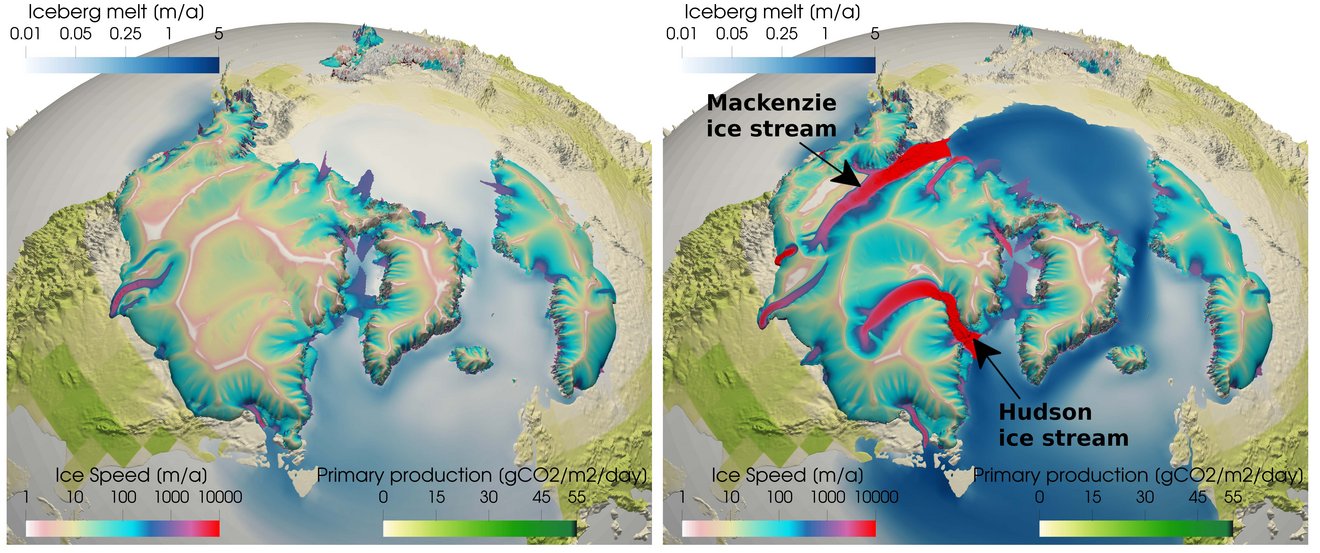The effect of climate perturbations on the timing of Heinrich events
Heinrich events are one of the prominent signals of glacial climate variability. They are characterized as abrupt, quasi-periodic episodes of ice-sheet instabilities during which large armadas of icebergs are released from the Laurentide ice sheet — the ice sheet covering the North American continent at the time. After a Heinrich event, the ice sheet grows back to its initial size before another Heinrich event occurs. Such cyclic changes between a large and a small ice sheet are referred to as an oscillatory system. In total, six of these events have been clearly identified in the paleo record over the course of the last glacial. By unraveling the processes behind the enigmatic Heinrich events, we enhance the confidence in our climate models and unlock the potential to investigate the vulnerability of present-day ice sheets to similar processes in the future.
To gain a better understanding of the driving mechanisms behind the occurrence of Heinrich events, Schannwell et al. employ a coupled ice sheet–solid earth model. They focus their analysis on two prominent ice streams of the Laurentide ice sheet: the Mackenzie ice stream and Hudson ice stream (Fig. 1). Both ice streams exhibit distinct glaciological and climatic settings. The Mackenzie ice stream terminates on land, discharges into the Arctic, and is located in the warmer climate of the north-western region of the North American continent. In contrast, the Hudson ice stream drains directly into the Labrador Sea and hence the Atlantic Ocean and is situated in the cooler climate of the eastern side of the continent.
Video of one of the simulations
The authors find that the distinct climatic and glaciological conditions of the two ice streams result in a different dynamical evolution of Heinrich events. For the Hudson ice stream the instabilities are initiated at the ice stream front and propagate upstream, while for the Mackenzie ice stream the initiation of instabilities occurs further upstream and propagates subsequently downstream. In systematic and idealized climate perturbation experiments, in which key climate parameters such as snowfall and surface temperature were varied in terms of magnitude and frequency, they find that both ice streams are practically unaffected by changes in the frequency of the climate forcing. However, while both ice streams also show qualitatively the same response to changing climatic conditions in the simulations, the response magnitudes to variations in surface temperatures and snowfall differ. The absence of any surface melting on Hudson ice stream means that ice-sheet instabilities are most affected by changes in snowfall. In comparison, the warmer climate conditions of the Mackenzie ice stream region lead to Heinrich events being primarily affected by changes in surface temperatures.
The warmer climate of the Mackenzie region also pushes this ice stream towards a critical threshold above which Heinrich events cannot occur anymore and the entire region turns into a steady ice stream. In the simulations, the transition from an oscillatory system to a steady streaming system raises global sea level by almost two meters and releases large amounts of freshwater into the Arctic, resulting in far-reaching climatic consequences. This makes the Mackenzie ice stream a likely candidate to have contributed to past abrupt climate change events, such as the Younger Dryas cold period between 12,900-11,600 years before present.
Original publication:
Schannwell, C., Mikolajewicz, U., Ziemen, F., and Kapsch, M.-L. (2023). Sensitivity of Heinrich-type ice-sheet surge characteristics to boundary forcing perturbations. Climate of the Past, 19, 179–198, https://cp.copernicus.org/articles/19/179/2023/.
Contact
Dr. Clemens Schannwell
Max Planck Institute for Meteorology
clemens.schannwell@mpimet.mpg.de
Uwe Mikolajewicz
Max Planck Institute for Meteorology
uwe.mikolajewicz@mpimet.mpg.de
Dr. Marie-Luise Kapsch
Max Planck Institute for Meteorology
marie-luise.kapsch@mpimet.mpg.de
Dr. Florian Ziemen
German Climate Computing Center
ziemen@dkrz.de

